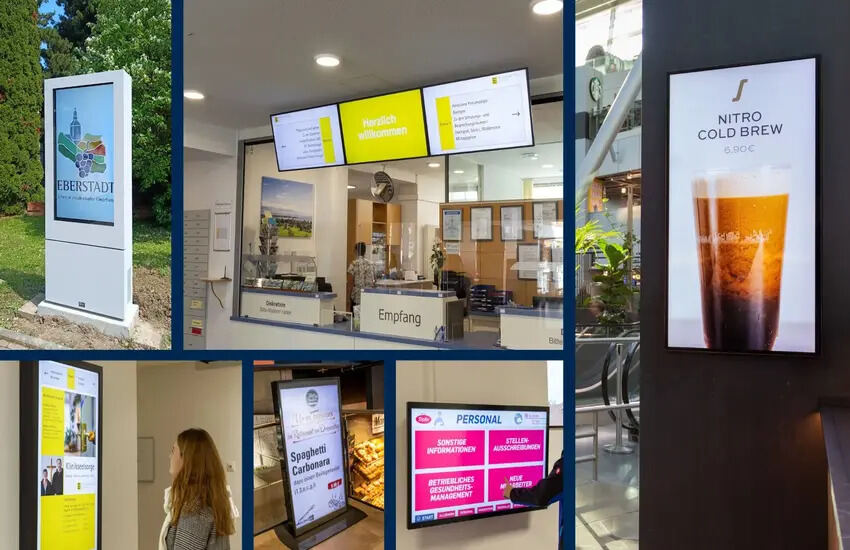Digital signage has transformed the way businesses communicate with their audiences, merging cutting-edge technology with creative content delivery. This article delves into the latest trends and innovations in digital signs, providing a comprehensive overview of what’s shaping the industry today.
The Rise of AI-Driven Digital Signage
Artificial Intelligence (AI) is revolutionizing the digital signage landscape. By incorporating machine learning algorithms, businesses can now deliver hyper-personalized content. AI enables systems to analyze data such as customer behavior, demographics, and location, tailoring messages in real time. This approach not only enhances user engagement but also boosts ROI.
Key Features of AI-Powered Signage:
- Dynamic Content Updates: AI systems adjust displays based on real-time data.
- Predictive Analytics: Identifying trends to optimize marketing strategies.
- Interactive Experiences: Enhancing customer interaction through AI chatbots and voice recognition.
Interactive and Touchless Solutions
The shift towards touchless technology has gained momentum, driven by the need for enhanced hygiene and convenience. Interactive kiosks now employ motion sensors, voice commands, and mobile integration, reducing the reliance on physical touch.
Examples of Touchless Innovations:
- Gesture Recognition: Users navigate screens through hand movements.
- Voice-Activated Displays: Commands are given using natural language.
- Mobile Integration: Customers control displays via smartphones or QR codes.
4K and 8K Ultra-High-Definition Displays
As display technology advances, 4K and 8K resolutions are setting new benchmarks for visual quality. These ultra-HD screens offer unmatched clarity, making them ideal for industries such as retail, hospitality, and entertainment.
Benefits of Ultra-HD Displays:
- Enhanced Visual Appeal: Vibrant colors and sharper images capture attention.
- Immersive Experiences: Perfect for video walls and interactive installations.
- Future-Proofing: Ensuring compatibility with evolving content standards.
Integration of IoT in Digital Signage
The Internet of Things (IoT) is enabling seamless connectivity between devices, creating smarter signage solutions. IoT sensors collect data from the environment, providing valuable insights to tailor content dynamically.
How IoT Enhances Digital Signage:
- Real-Time Data: Temperature, foot traffic, and weather data influence display content.
- Remote Management: Centralized control of multiple signage systems.
- Energy Efficiency: Automated brightness and power settings reduce energy consumption.
Programmatic Advertising on Digital Signage
Programmatic advertising has entered the digital signage space, allowing advertisers to buy and place ads with precision. This automated process ensures the right message reaches the right audience at the right time.
Advantages of Programmatic Advertising:
- Targeted Campaigns: Focused on specific demographics and locations.
- Real-Time Bidding: Maximizing ad spend efficiency.
- Performance Analytics: Measuring campaign success with detailed metrics.
Sustainability in Digital Signage
As environmental concerns grow, businesses are turning to sustainable digital signage solutions. Energy-efficient displays, recyclable materials, and solar-powered systems are becoming mainstream.
Sustainable Practices in Digital Signage:
- Eco-Friendly Displays: LED and e-paper screens consume less energy.
- Recycling Initiatives: Encouraging responsible disposal of outdated equipment.
- Solar Integration: Using renewable energy sources to power signage systems.
Augmented Reality (AR) Integration
Augmented Reality (AR) is merging the physical and digital worlds, creating immersive and engaging experiences. AR-enabled signage offers interactive features that captivate audiences.
Applications of AR in Digital Signage:
- Virtual Try-Ons: Customers can visualize products like clothing or eyewear.
- Interactive Games: Engaging audiences through gamified experiences.
- Enhanced Navigation: Providing 3D directions in malls or airports.
Cloud-Based Content Management Systems (CMS)
Cloud-based CMS platforms simplify the management of digital signage networks, making it easier for businesses to update content across multiple locations.
Features of Cloud-Based CMS:
- Remote Accessibility: Update content from anywhere with an internet connection.
- Scalability: Easily manage large networks of displays.
- Security: Protect data with robust encryption and monitoring tools.
The Role of Data Analytics in Digital Signage
Data analytics is driving the effectiveness of digital signage by providing actionable insights. Metrics such as engagement rates, dwell times, and conversion rates help businesses refine their strategies.
Benefits of Data-Driven Digital Signage:
- Personalized Content: Delivering relevant messages based on audience preferences.
- Campaign Optimization: Adjusting strategies based on performance data.
- Enhanced ROI: Maximizing the impact of marketing investments.
Conclusion
Digital signage continues to evolve, embracing trends and innovations that redefine its capabilities. From AI-driven personalization to sustainable solutions, the possibilities are endless. Businesses that adopt these advancements will not only enhance their communication strategies but also stay ahead in an increasingly competitive market.







